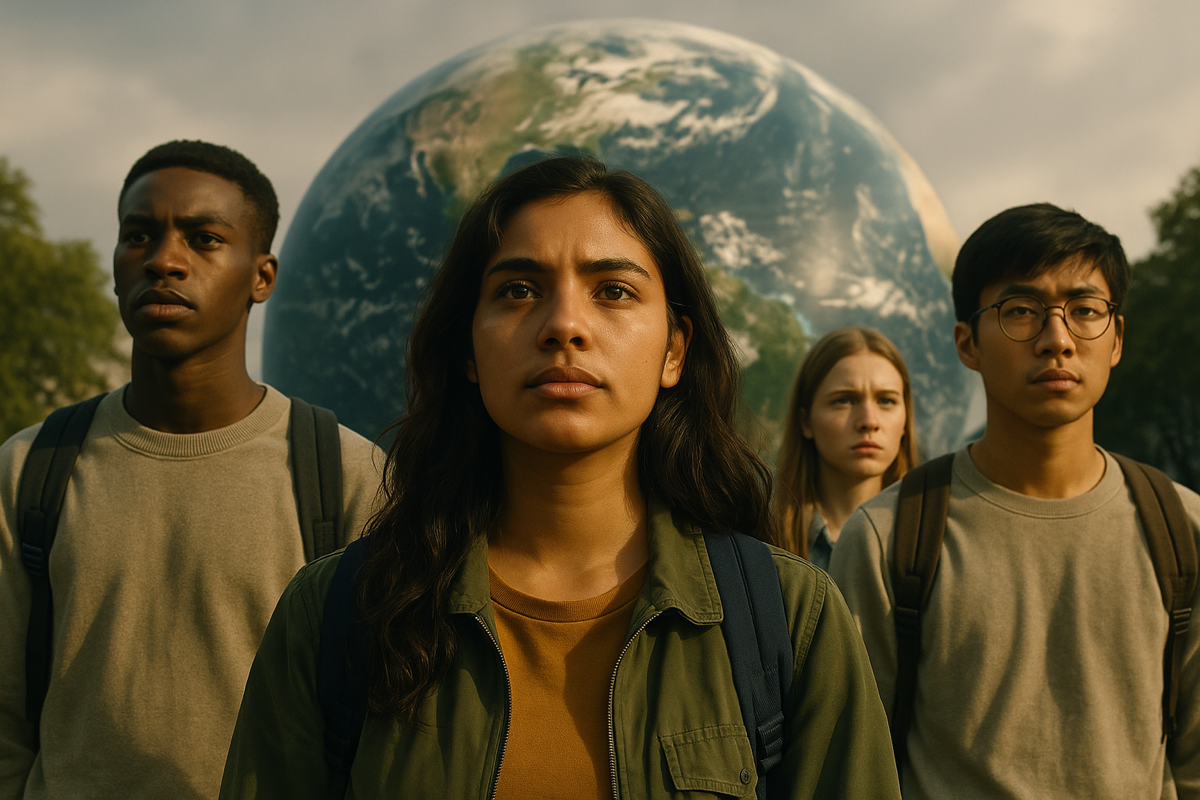
 John Moravec
John MoravecThe missing planet
A school day begins with a bell. Students move from worksheets to whiteboards while forests burn and rivers shrink outside. Children memorize the parts of a leaf while the trees that once bore them vanish. School routines continue, unaware (or unwilling to acknowledge) that the world beyond the classroom is unraveling.
The structure of modern education mirrors the industrial systems that helped fuel our ecological crisis: extractive, hierarchical, and standardized. Schools prepare students for the world that caused collapse, not for the one that must emerge after it.
From Manifesto 25:
An education that ignores the planet is an education without a future. With climate catastrophe looming, any curriculum that neglects environmental stewardship is both deficient and irresponsible. Education must actively shape students’ futures and the world around them. Learners should not passively study the environment; they must be empowered as co-creators of solutions and active guardians of the planet. By enabling students with future-ready skills and agency to address grand challenges, and integrating planetary-focused literacies into a dynamic, flexible learning process, we foster innovation and a personal connection to sustainability that inspires lasting impact.
Climate collapse is the defining reality of our time, globally. The task before us is to reinvent education so that sustainability and care for the planet are not side lessons, but foundations for how we learn, teach, and live.
Stewardship (taking care of the planet) is a good starting point, but we must go further. The Earth will continue for billions of years, but human life on it will not …unless we change course.
Today’s learners must be empowered to address the causes of the crisis, moving beyond adaptation. This calls for an education that sees them not as future workers or consumers, but as planetary citizens, individuals with the insight, agency, and responsibility to help shape a livable future.
Educating beyond climate awareness
For decades, schools have taught about the environment. Posters explain the water cycle. Classrooms celebrate Earth Day. Occasionally, students build solar ovens or sort recycling bins. But too often, environmental education ends at awareness. It names problems without equipping students to address them. It shows the consequences of collapse but not the tools for action. The result is a generation that feels informed, but disempowered, alert to crisis, yet unsure how or where to respond.
Stewardship begins where awareness ends. It emerges when learners are invited to participate in—and shape—the world..
True empowerment means that students see themselves as agents of change, not passive recipients of knowledge. This is where the fusion of agency and self-efficacy becomes essential. Agency gives learners real choices. Self-efficacy gives them the belief that those choices matter. When relevance is integrated into learning (i.e., when students can connect their skills to the challenges around them) education becomes a purpose-driven response to the world.
Consider youth-led sustainability councils, which are now active in cities from Nairobi to New York. These are not symbolic bodies. Students audit energy use in their schools, redesign waste management systems, and present policy recommendations to school boards. In some cases, their ideas have shifted district budgets. They engage in building the future.
Or take community mapping projects, where learners document local air quality, food insecurity, or access to green space. Using open-source tools and guided inquiry, students create real data for their neighborhoods. These maps show learners their place in the ecosystem and their power to make that ecosystem more just.
Many of the most impactful efforts occur outside the formal classroom. Environmental clubs partner with local farms. Teenagers design apps for tracking bird migration. Young people organize climate teach-ins or public art projects to inspire change. These informal and nonformal spaces often do more to foster environmental responsibility than any textbook unit ever could. They thrive because they are learner-driven, connected to place, and rooted in care.
Empowerment is a practice. When education supports students in acting meaningfully within their communities, it builds lasting habits of engagement. And as those habits grow, so does the capacity to think beyond the individual and act on behalf of the collective, the future, and the planet itself.
Planetary literacies for a livable future
To respond meaningfully to ecological collapse, learners need more than sets of information; they need new ways of perceiving, imagining, and participating. Planetary literacies offer a foundation for understanding complexity, anticipating change, and shaping more livable futures with care and clarity. These are not subjects to be added to the curriculum, but lenses that reframe how all learning happens.
Three core literacies help learners navigate this moment: ecological literacy, futures literacy, and systems thinking.
- Ecological literacy grounds learning in the patterns of the living world. It invites students to explore interdependence, resilience, biodiversity, and limits as conditions of life. Ecologically literate learners understand how water cycles through a watershed, how forests regulate climate, and how waste becomes nourishment in healthy ecosystems. This literacy cultivates reverence alongside knowledge. It teaches that humans are not separate from nature but embedded within it.
- Futures literacy, as promoted by UNESCO (2019), builds the capacity to imagine and prepare for many possible futures. It trains learners to question assumptions, anticipate consequences, and expand their sense of what’s possible. The goal is to develop strategies for exploring alternatives and navigating uncertainty with creativity. Futures-literate students don’t ask, “What will happen to us?” They ask, “What could we do to help form preferred futures, together?”
- Systems thinking helps learners perceive the loops, layers, and feedback dynamics of complex systems, whether ecological, social, or technological. It teaches that problems are rarely linear, that causes and consequences are often distant in time and space, and that change in one part of a system can ripple through the whole. With this literacy, students learn to connect dots across disciplines and scales, to see patterns, and to design more thoughtful interventions.
These literacies are already echoed in global frameworks. The OECD’s (2018) Future of education and skills 2030 project emphasizes systems thinking and anticipation as key competencies for navigating complexity. UNESCO’s (2021) Reimagining our futures together report urges schools to prepare learners for ecological transformation and civic imagination. Manifesto 25 calls for “future-ready skills” that blend personal agency with collective responsibility, a broader expression of planetary literacies.
What unites these approaches is perspective over content. A math class might model climate feedback loops. A literature seminar might explore speculative fiction as a tool for imagining different futures. A history unit might trace how industrial energy systems shaped modern inequality. Across subjects, planetary literacies connect learning to life.
To learn for a livable future, education must nurture minds that can think across boundaries, imagine beyond crisis, and act with care in a fragile, interdependent world.
Pedagogies that regenerate
We cannot teach for a living planet with dead pedagogies. If we are to prepare learners to live well in an age of ecological uncertainty, we must also transform how learning happens. Regenerative education requires pedagogies that are attuned to place, culture, and complexity. It demands a shift from rigid delivery to dynamic participation, from abstraction to connection, and from fragmentation to wholeness.
First, we must move beyond curriculum silos. The climate crisis does not respect academic departments, and neither should our approach to learning. Regenerative pedagogies embrace integrated, interdisciplinary learning that mirrors the complexity of real-world challenges. A single project (e.g., restoring a local wetland) can draw on biology, ethics, data analysis, storytelling, and civics. Students don’t merely learn about systems. They learn within them.
Second, we must reconnect education to place. For many learners, school has become an entirely indoor affair: disconnected from the seasons, shielded from the weather, and insulated from the land. Regenerative learning invites learners outside—into forests, rivers, gardens, and communities. Forest schools immerse children in ecological cycles. Indigenous-led land-based education, grounded in relational worldviews, teaches learners to listen, observe, and act in ways that honor interdependence and responsibility. Even where access to nature is limited, virtual visits to ecologically vulnerable areas (such as disappearing coastlines or fragile coral reefs) can help cultivate emotional and cognitive connection across distance.
Third, we must shift from performance to participation. In conventional classrooms, students are often tasked with repeating knowledge to prove they’ve learned. In contrast, regenerative pedagogies invite them to participate in knowledge creation, i.e., to ask questions, propose solutions, test ideas, and reflect on the outcomes. It’s the difference between writing a paper on climate change and organizing a local campaign to reduce waste. Participation turns learning into lived experience.
We see this in models such as:
- Forest schools (originating in Scandinavia) that center nature as both setting and teacher, nurturing resilience, curiosity, and ecological connection.
- Indigenous-led land learning, such as those practiced by Māori and First Nations educators, that embed ancestral wisdom and stewardship in every lesson.
- Teach the Future, a global movement empowering youth to integrate climate futures into every subject, not as a niche topic but as an ethical imperative.
- Green School Bali, where sustainability is a way of life, from bamboo classrooms to community partnerships and renewable energy systems.
Technology, too, has a role to play, but only when used with purpose. Interactive simulations, real-time environmental data dashboards, and global collaboration platforms can support ecological learning when they connect learners meaningfully to each other and to the world.
Teaching for the planet requires more than awareness campaigns or science units on climate. It calls for a whole-pedagogy approach: one that regenerates our connection to land, to each other, and to the future. This prepares learners to think differently, across scales, across disciplines, and across generations.
Reclaiming education for the earth
If the industrial age turned education into a mechanism for managing resources (human and ecological alike) the coming era must reclaim it as a force for regeneration. Education cannot remain an instrument of the very systems that eroded the planet’s resilience. It must become a living, adaptive practice that helps us repair, restore, and reimagine our relationship with the Earth.
This means more than teaching about sustainability. It requires rethinking what education is for and for whom it is designed to benefit.
A regenerative education asks: What kind of world are we preparing learners to inherit and co-create? It sees every lesson as a potential act of healing. When students plant trees, test soil, restore native species, and listen to elders share stories of a place before it was paved over, they become caretakers. When they imagine better futures and organize for change, they embody the possibility that learning can make things whole again.
This is about survival. And it is already happening in bits and pieces that add up toward making a difference: schools that compost their food waste, in classrooms that transform stormwater into gardens, and in youth organizing themselves to demand climate action. These are small-scale practices with deep cultural implications: they teach learners that their actions matter, that interconnection is real, and that education has the power to regenerate life, not extract from it.
But to scale this shift, we must confront a deeper challenge: How do we design learning environments that heal rather than harm? Environments that resist extractive rhythms of testing and ranking, and instead support rhythms of restoration, reflection, and responsibility? How do we center local ecologies, ancestral knowledge, and lived experience as the heart of the curriculum?
It starts with vision. A commitment to aligning the daily practices of education with the living systems that sustain us. A willingness to treat learners as planetary citizens, not future workers. And a belief that schools can be sanctuaries for reimagining our collective life on Earth.
Education must help us live better with the Earth or it will have failed its purpose entirely.
Read and sign Manifesto 25 at https://manifesto25.org
References
OECD. (2018). The future of education and skills: Education 2030—The OECD learning compass 2030. Organisation for Economic Co-operation and Development. https://www.oecd.org/education/2030-project/
Scardamalia, M., & Bereiter, C. (2010). A brief history of knowledge building. Canadian Journal of Learning and Technology, 36(1). https://doi.org/10.21432/T2859M
UNESCO. (2019). Embracing a culture of futures thinking: Futures literacy in education. United Nations Educational, Scientific and Cultural Organization. https://unesdoc.unesco.org/ark:/48223/pf0000374112
UNESCO. (2021). Reimagining our futures together: A new social contract for education. United Nations Educational, Scientific and Cultural Organization. https://unesdoc.unesco.org/ark:/48223/pf0000379707

